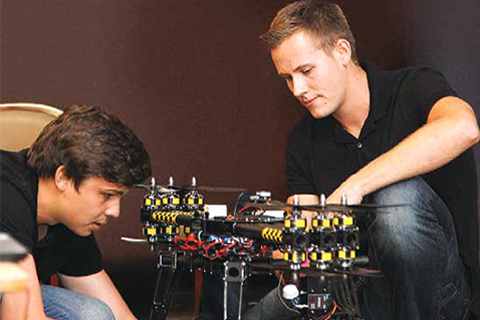Aerial cinematography has traditionally been a spectacular but costly component of film and television, but that could change thanks to an unmanned aerial vehicle, or drone, called Air Xposure.
The device, which was codeveloped by a U of T student and a recent graduate, has sufficient power and stability to carry a highend movie camera up to 120 metres aloft. It shoots footage that its creators say is as good as what comes from a piloted helicopter or movie crane, but at a fraction of the cost and prep time.
Measuring only a few feet across, the Air Xposure drone is highly maneuverable, quick to set up, and as steady as if it were mounted on a dolly. “Most of the development was in the stabilization of movement,” says Denis Loboda, a 2013 mechanical engineering grad, who created the device with fifth-year student Peter Izraelski. “When people think about stabilization, they think of the Steadicam, which is based on gravity. Ours is different because it’s actively driven by motors.”
The stabilizer uses a gyroscope and an accelerometer (similar to what is found in many smartphones) to take more than 2,000 readings per second. Any bounce, jounce or shift sends an instantaneous message to the control system to compensate. The result, says Loboda: shake- and vibration-free, professional quality footage. The director can attach any movie camera to the stabilizer, and the same machines that keep the shot steady can also be used to control pan and yaw.
Air Xposure’s six helicopter rotors allow the craft to remain perfectly stationary, or to move slowly in a desired direction. It can be operated by remote control and is precise within a foot, Loboda says. A traditional crane shot can take a couple of hours to set up – more in uneven terrain. In contrast Loboda says Air Xposure can be airborne in “two minutes.”
Loboda and Izraelski are now pitching their device to movie and television companies around the world. Loboda says they have to move quickly. Competing drones can’t yet match Air Xposure’s stability, but that advantage won’t last long.
The pair started developing the device this past May. With a mentor from the Faculty of Applied Science and Engineering’s Entrepreneurship Hatchery, they conducted extensive market research and are hoping to have an established clientele by early 2014, well in time for summer – high season for movie and television shoots.
Even as he works toward taking Hollywood by remote-controlled storm, Loboda says he and his team are already discovering unexpected applications for their device. “We have been told Air Xposure would be very useful for the construction industry,” Loboda says. “If they were building a condo tower, we could provide them with shots of what the view would look like from the top of that building.”
Recent Posts
U of T’s 197th Birthday Quiz
Test your knowledge of all things U of T in honour of the university’s 197th anniversary on March 15!
Are Cold Plunges Good for You?
Research suggests they are, in three ways
Work Has Changed. So Have the Qualities of Good Leadership
Rapid shifts in everything from technology to employee expectations are pressuring leaders to constantly adapt







One Response to “ Pictures from Above ”
The Hatchery is here for U of T students! Apply : http://hatchery.engineering.utoronto.ca/students/ Talk to us: hatchery@ecf.utoronto.ca
Come to our events: http://hatchery.engineering.utoronto.ca/calender/
Joseph Orozco, Executive Director, Entrepreneurship - The Hatchery